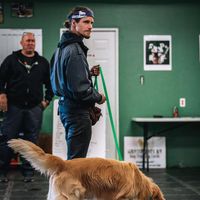Jan 20 (edited) in Blog Posts
Teaching Place: Show Your Dog How To Be Calm
Today we are going to explore one of the most useful beginner commands - the “Place” command. This simple command involves sending your dog to a predetermined spot and stay until released. It isn’t just a useful command, it also is a great command to start working on basic communication and eventually nudge them towards self-control and the ability to be calm in any situation. Let's dive in!
The Basics of "Place":
To start off, lets decide what Place is to your dog. Your dog’s place can be anything you decide, it can be a dog bed, a blanket on the ground, or anything that the dog can see as a distinct Place. With that said, I recommend starting with an elevated dog bed, sometimes called a dog cot. These beds create a clear elevated surface, making the choice to go on and off Place more distinct to both the dog and trainer, as an added benefit they are cheap, provide cooling, and are easy to use outdoors. Any time we can eliminate Grey Zones we are going in the right direction.
When you have chosen your Place the next step is to teach the command. Use a lure or leash pressure to encourage your dog to go on Place, then mark and reward them for it. When they seem to get the idea that going on Place is a great thing, say your command “Place” before you apply your lure or leash pressure. Put some practice in and they should be enthusiastically going onto the bed in no time. Especially if this is one of their first commands, it is a great opportunity to practice your basics such as your marker, practicing following a lure, and giving to leash pressure. Remember, there is only one rule for Place, keep four paws on the bed. Simple, clear, and obvious, everything you want in a command.
Impulse Control and Self-Soothing:
Once the command is pretty solid we start to work on duration. This is where the real benefits kick in. Start by working up to a decent duration, aim for at least 10-15 minutes. Then add some distractions, these don’t need to be anything crazy, even doing the dishes while your dog maintains this command will serve as a great real-world distraction when starting out. Now your dog isn’t just practicing their command but also impulse control.
At this point you can take a step up again, aiming for 30-45 minutes of Place. Now we start into the territory of teaching calm, I call it Doggy Meditation. By insisting that they stay on Place for a long duration, we force them to begin practicing calm. They have nothing to do and that is okay! Your dog doesn’t need to be constantly entertained. When you combine regular Doggy Meditation practice with plenty of fulfillment and exercise at other times you are teaching your dog to “turn off” when necessary. This is a life saver if you have guests or just want to relax and watch a movie.
A Safe Haven in Bustling Environments:
One category of dogs that I insist need this command is the anxious and easily overwhelmed. By providing this calm space for them you don’t just practice the dog being calm but you also give them a retreat. With these dogs, I add one more rule, but it isn’t a rule for the dog, it is for the humans. If your dog retreats to their Place visitors, guests, and kids have to leave them alone. Now your dog has agency, they can regulate their own stress levels. Instead of simply dealing with the overwhelming environment they can communicate their desires in a clear and polite way by simply removing themselves.
By mastering this command you and your dog gain many valuable tools. This command is a great example of a Micro goal that greatly affects many Macro goals when practiced correctly. Use this command to help your dog practice impulse control, and gain a sense of calm and self-regulation, but also to add structure to your home and allow you more freedom as your dog naps happily on their bed.
0
0 comments

skool.com/the-k9-classroom-4030
Providing free dog training information. Improving the lives of both owners and their dogs through education.
powered by
